Research Progress of Electrically Driven Multi-Stable Cholesteric Liquid Crystals
Abstract
1. Introduction
2. Electrically Driven Multi-Stable Modes of Cholesteric Liquid Crystals
2.1. Bistable Mode
2.2. Tri-Stable Mode
2.3. Multi-Stable Mode
3. Performance Optimization
3.1. Optimization of Contrast Ratio
3.2. Optimization of Switching Time
3.3. Optimization of Mechanical Properties
4. Application
5. Conclusions
Author Contributions
Funding
Institutional Review Board Statement
Informed Consent Statement
Data Availability Statement
Conflicts of Interest
References
- Wu, W.G.; Wu, P.C.; Lee, W. All-electrical switching and electrothermo-optical response of a tristable smectic-A liquid crystal. J. Mol. Liq. 2021, 325, 114566. [Google Scholar] [CrossRef]
- Li, C.C.; Tseng, H.Y.; Chen, C.W.; Wang, C.T.; Jau, H.C.; Wu, Y.C.; Hsu, W.H.; Lin, T.H. Versatile Energy-Saving Smart Glass Based on Tristable Cholesteric Liquid Crystals. ACS Appl. Energ. Mater. 2020, 3, 7601–7609. [Google Scholar] [CrossRef]
- Zhao, D.Y.; Huang, W.; Cao, H.; Zheng, Y.D.; Wang, G.J.; Yang, Z.; Yang, H. Homeotropic Alignment of Nematic Liquid Crystals by a Photocross-Linkable Organic Monomer Containing Dual Photofunctional Groups. J. Phys. Chem. B 2009, 113, 2961–2965. [Google Scholar] [CrossRef] [PubMed]
- Hunter, J.T.; Pal, S.K.; Abbott, N.L. Adsorbate-Induced Ordering Transitions of Nematic Liquid Crystals on Surfaces Decorated with Aluminum Perchlorate Salts. ACS Appl. Mater. Interfaces 2010, 2, 1857–1865. [Google Scholar] [CrossRef]
- Yoon, W.J.; Lee, K.M.; Evans, D.R.; McConney, M.E.; Kim, D.Y.; Jeong, K.U. Giant surfactants for the construction of automatic liquid crystal alignment layers. J. Mater. Chem. C 2019, 7, 8500–8514. [Google Scholar] [CrossRef]
- Kim, S.G.; Kim, S.M.; Kim, Y.S.; Lee, H.K.; Lee, S.H.; Lee, G.D.; Lyu, J.J.; Kim, K.H. Stabilization of the liquid crystal director in the patterned vertical alignment mode through formation of pretilt angle by reactive mesogen. Appl. Phys. Lett. 2007, 90, 261910. [Google Scholar] [CrossRef]
- Liu, B.Y.; Chen, L.J. Role of Surface Hydrophobicity in Pretilt Angle Control of Polymer-Stabilized Liquid Crystal Alignment Systems. J. Phys. Chem. C 2013, 117, 13474–13478. [Google Scholar] [CrossRef]
- Sharma, V.; Kumar, P.; Raina, K.K. Simultaneous effects of external stimuli on preparation and performance parameters of normally transparent reverse mode polymer-dispersed liquid crystals—A review. J. Mater. Sci. 2021, 56, 18795–18836. [Google Scholar] [CrossRef]
- Zhao, R.; Li, X.S.; Wang, K.M.; Huai, H.; Ma, H.M.; Sun, Y.B. Effect of the introduction of mono-functional monomer on the electro-optic properties of reverse-mode polymer stabilised cholesteric liquid crystal. Liq. Cryst. 2021, 48, 1162–1174. [Google Scholar] [CrossRef]
- Hu, X.W.; Zhang, X.M.; Yang, W.M.; Jiang, X.F.; Jiang, X.S.; de Haan, L.T.; Yuan, D.; Zhao, W.; Zheng, N.; Jin, M.L.; et al. Stable and scalable smart window based on polymer stabilized liquid crystals. J. Appl. Polym. Sci. 2020, 137, 48917. [Google Scholar] [CrossRef]
- Meng, C.L.; Chen, E.G.; Wang, L.P.; Tang, S.T.; Tseng, M.C.; Guo, J.; Ye, Y.; Yan, Q.F.; Kwok, H. Color-switchable liquid crystal smart window with multi-layered light guiding structures. Opt. Express 2019, 27, 13098–13107. [Google Scholar] [CrossRef] [PubMed]
- Jeon, B.G.; Choi, T.H.; Do, S.M.; Woo, J.H.; Yoon, T.H. Effects of Curing Temperature on Switching Between Transparent and Translucent States in a Polymer-Stabilized Liquid-Crystal Cell. IEEE Trans. Electron Devices 2018, 65, 4387–4393. [Google Scholar] [CrossRef]
- Sun, H.T.; Xie, Z.P.; Ju, C.; Hu, X.W.; Yuan, D.; Zhao, W.; Shui, L.L.; Zhou, G.F. Dye-Doped Electrically Smart Windows Based on Polymer-Stabilized Liquid Crystal. Polymers 2019, 11, 694. [Google Scholar] [CrossRef] [PubMed]
- Zhou, Y.; You, Y.X.; Liao, X.L.; Liu, W.; Zhou, L.; Zhang, B.B.; Zhao, W.; Hu, X.W.; Zhang, L.Y.; Yang, H.; et al. Effect of Polymer Network Topology on the Electro-Optical Performance of Polymer Stabilized Liquid Crystal (PSLC) Devices. Macromol. Chem. Phys. 2020, 221, 2000185. [Google Scholar] [CrossRef]
- Bao, R.; Liu, C.M.; Yang, D.K. Smart Bistable Polymer Stabilized Cholesteric Texture Light Shutter. Appl. Phys. Express 2009, 2, 112401. [Google Scholar] [CrossRef]
- Liang, H.H.; Wu, C.C.; Wang, P.H.; Lee, J.Y. Electro-thermal switchable bistable reverse mode polymer stabilized cholesteric texture light shutter. Opt. Mater. 2011, 33, 1195–1202. [Google Scholar] [CrossRef]
- Wang, C.H.; Wu, C.C.; Yang, Y.T.; Chiu, T.L.; Lee, J.Y.; Lee, J.H. Reverse-Mode Polymer-Stabilized Dual-Frequency Cholesteric Texture Cell for Dual Mode Operations. J. Disp. Technol. 2012, 8, 663–668. [Google Scholar] [CrossRef]
- Lu, H.B.; Xu, W.; Song, Z.G.; Zhang, S.N.; Qiu, L.Z.; Wang, X.H.; Zhang, G.B.; Hu, J.T.; Lv, G.Q. Electrically switchable multi-stable cholesteric liquid crystal based on chiral ionic liquid. Opt. Lett. 2014, 39, 6795–6798. [Google Scholar] [CrossRef]
- Mo, L.Y.; Sun, H.T.; Liang, A.H.; Jiang, X.F.; Shui, L.L.; Zhou, G.F.; de Haan, L.T.; Hu, X.W. Multi-stable cholesteric liquid crystal windows with four optical states. Liq. Cryst. 2022, 49, 289–296. [Google Scholar] [CrossRef]
- Hung, Y.H.; Chang, K.T.; Chiu, Z.Y.; Chang, J.Y.; Yen, K.T.; Liu, C.Y. Fabrication of high-transmittance and fast-response bistable dual-frequency CLC cells. J. Taiwan Inst. Chem. Eng. 2023, 146, 104866. [Google Scholar] [CrossRef]
- Cao, X.L.; Xiong, Y.; Sun, J.; Zhu, X.X.; Sun, Q.J.; Wang, Z.L. Piezoelectric Nanogenerators Derived Self-Powered Sensors for Multifunctional Applications and Artificial Intelligence. Adv. Funct. Mater. 2021, 31, 2102983. [Google Scholar] [CrossRef]
- Vijayakanth, T.; Liptrot, D.J.; Gazit, E.; Boomishankar, R.; Bowen, C.R. Recent Advances in Organic and Organic-Inorganic Hybrid Materials for Piezoelectric Mechanical Energy Harvesting. Adv. Funct. Mater. 2022, 32, 2109492. [Google Scholar] [CrossRef]
- Ranjkesh, A.; Yoon, T.H. Ultrathin, transparent, thermally-insulated, and energy-efficient flexible window using coatable chiral-nematic liquid crystal polymer. J. Mol. Liq. 2021, 339, 116804. [Google Scholar] [CrossRef]
- Du, X.X.; Li, Y.; Liu, Y.J.; Wang, F.; Luo, D. Electrically switchable bistable dual frequency liquid crystal light shutter with hyper-reflection in near infrared. Liq. Cryst. 2019, 46, 1727–1733. [Google Scholar] [CrossRef]
- Yu, B.H.; Huh, J.W.; Heo, J.; Yoon, T.H. Simultaneous control of haze and transmittance using a dye-doped cholesteric liquid crystal cell. Liq. Cryst. 2015, 42, 1460–1464. [Google Scholar] [CrossRef]
- Nemati, H.; Yang, D.K.; Cheng, K.L.; Liang, C.C.; Shiu, J.W.; Tsai, C.C.; Zola, R.S. Effect of surface alignment layer and polymer network on the Helfrich deformation in cholesteric liquid crystals. J. Appl. Phys. 2012, 112, 124513. [Google Scholar] [CrossRef]
- West, J.L.; Akins, R.B.; Francl, J.; Doane, J.W. Cholesteric/polymer dispersed light shutters. Appl. Phys. Lett. 1993, 63, 1471–1473. [Google Scholar] [CrossRef][Green Version]
- Yang, D.-K.; West, J.L.; Chien, L.-C.; Doane, J.W. Control of reflectivity and bistability in displays using cholesteric liquid crystals. J. Appl. Phys. 1994, 76, 1331–1333. [Google Scholar] [CrossRef]
- Lin, K.W.; Tseng, H.Y.; Chang, L.M.; Li, C.C.; Wang, C.T.; Lin, T.H. Mechanism of scattering bistable light valves based on salt-doped cholesteric liquid crystals. Opt. Express 2021, 29, 41213–41221. [Google Scholar] [CrossRef]
- Heilmeier, G.H.; Zanoni, L.A.; Barton, L.A. Dynamic Scattering: A New Electrooptic Effect in Certain Classes of Nematic Liquid Crystals. Proc. IEEE 1968, 56, 1162–1171. [Google Scholar] [CrossRef]
- Moheghi, A.; Nemati, H.; Li, Y.N.; Li, Q.; Yang, D.K. Bistable salt doped cholesteric liquid crystals light shutter. Opt. Mater. 2016, 52, 219–223. [Google Scholar] [CrossRef]
- Sung, G.F.; Wu, P.C.; Zyryanov, V.Y.; Lee, W. Electrically active and thermally passive liquid-crystal device toward smart glass. Photonics Res. 2021, 9, 2288–2295. [Google Scholar] [CrossRef]
- Kumar, P.; Kang, S.W.; Lee, S.H. Advanced bistable cholesteric light shutter with dual frequency nematic liquid crystal. Opt. Mater. Express 2012, 2, 1121–1134. [Google Scholar] [CrossRef]
- Hsiao, Y.C.; Tang, C.Y.; Lee, W. Fast-switching bistable cholesteric intensity modulator. Opt. Express 2011, 19, 9744–9749. [Google Scholar] [CrossRef] [PubMed]
- Ma, J.; Shi, L.; Yang, D.K. Bistable Polymer Stabilized Cholesteric Texture Light Shutter. Appl. Phys. Express 2010, 3, 021702. [Google Scholar] [CrossRef]
- Li, C.C.; Tseng, H.Y.; Pai, T.W.; Wu, Y.C.; Hsu, W.H.; Jau, H.C.; Chen, C.W.; Lin, T.H. Bistable cholesteric liquid crystal light shutter with multielectrode driving. Appl. Opt. 2014, 53, E33–E37. [Google Scholar] [CrossRef] [PubMed]
- Hsiao, Y.C.; Hou, C.T.; Zyryanov, V.Y.; Lee, W. Multichannel photonic devices based on tristable polymer-stabilized cholesteric textures. Opt. Express 2011, 19, 23952–23957. [Google Scholar] [CrossRef] [PubMed]
- Inoue, Y.; Moritake, H. Formation of a defect-free uniform lying helix in a thick cholesteric liquid crystal cell. Appl. Phys. Express 2015, 8, 071701. [Google Scholar] [CrossRef]
- Wang, C.T.; Wang, W.Y.; Lin, T.H. A stable and switchable uniform lying helix structure in cholesteric liquid crystals. Appl. Phys. Lett. 2011, 99, 041108. [Google Scholar] [CrossRef]
- Broughton, B.J.; Clarke, M.J.; Morris, S.M.; Blatch, A.E.; Coles, H.J. Effect of polymer concentration on stabilized large-tilt-angle flexoelectro-optic switching. J. Appl. Phys. 2006, 99, 023511. [Google Scholar] [CrossRef]
- Kim, S.H.; Chien, L.C.; Komitov, L. Short pitch cholesteric electro-optical device stabilized by nonuniform polymer network. Appl. Phys. Lett. 2005, 86, 161118. [Google Scholar] [CrossRef]
- Kim, S.H.; Shi, L.; Chien, L.C. Fast flexoelectric switching in a cholesteric liquid crystal cell with surface-localized polymer network. J. Phys. D Appl. Phys. 2009, 42, 195102. [Google Scholar] [CrossRef]
- Nian, Y.L.; Wu, P.C.; Lee, W. Optimized frequency regime for the electrohydrodynamic induction of a uniformly lying helix structure. Photonics Res. 2016, 4, 227–232. [Google Scholar] [CrossRef]
- Wu, P.C.; Hsiao, C.Y.; Lee, W. Photonic Bandgap-Cholesteric Device with Electrical Tunability and Optical Tristability in Its Defect Modes. Crystals 2017, 7, 184. [Google Scholar] [CrossRef]
- Patel, J.S.; Meyer, R.B. Flexoelectric electro-optics of a cholesteric liquid crystal. Phys. Rev. Lett. 1987, 58, 1538–1540. [Google Scholar] [CrossRef] [PubMed]
- Lee, S.-D.; Patel, J.S. Surface effect on the field-induced structural change near the isotropic-cholesteric transition. Phys. Rev. A At. Mol. Opt. Phys. 1990, 42, 997–1000. [Google Scholar] [CrossRef]
- Yu, C.H.; Wu, P.C.; Lee, W. Electro-Thermal Formation of Uniform Lying Helix Alignment in a Cholesteric Liquid Crystal Cell. Crystals 2019, 9, 183. [Google Scholar] [CrossRef]
- Zhang, Y.; Yang, X.L.; Zhan, Y.Y.; Zhang, Y.; He, J.L.; Lv, P.R.; Yuan, D.; Hu, X.W.; Liu, D.Q.; Broer, D.J.; et al. Electroconvection in Zwitterion-Doped Nematic Liquid Crystals and Application as Smart Windows. Adv. Opt. Mater. 2021, 9, 2001465. [Google Scholar] [CrossRef]
- Seo, J.H.; Huh, J.W.; Sohn, H.J.; Lim, E.; Yoon, T.H. Analysis of Optical Performance Degradation in an Ion-Doped Liquid-Crystal Cell with Electrical Circuit Modeling. Crystals 2020, 10, 55. [Google Scholar] [CrossRef]
- Gardiner, D.J.; Morris, S.M.; Hands, P.J.W.; Castles, F.; Qasim, M.M.; Kim, W.S.; Choi, S.S.; Wilkinson, T.D.; Coles, H.J. Spontaneous induction of the uniform lying helix alignment in bimesogenic liquid crystals for the flexoelectro-optic effect. Appl. Phys. Lett. 2012, 100, 063501. [Google Scholar] [CrossRef]
- Yu, C.H.; Wu, P.C.; Lee, W. Alternative generation of well-aligned uniform lying helix texture in a cholesteric liquid crystal cell. AIP Adv. 2017, 7, 105107. [Google Scholar] [CrossRef]
- Rudquist, P.; Komitov, L.; Lagerwall, S.T. Linear electro-optic effect in a cholesteric liquid crystal. Phys. Rev. E Stat. Phys. Plasmas Fluids 1994, 50, 4735–4743. [Google Scholar] [CrossRef] [PubMed]
- Rudquist, P.; Komitov, L.; Lagerwall, S.T. Volume-stabilized ULH structure for the flexoelectro-optic effect and the phase-shift effect in cholesterics. Liq. Cryst. 1998, 24, 329–334. [Google Scholar] [CrossRef]
- Kim, S.K.; Lee, K.S.; Kortright, J.B.; Shin, S.-C. Soft X-ray resonant Kerr rotation measurement and simulation of element-resolved and interface-sensitive magnetization reversals in a NiFe/FeMn/Co trilayer structure. Appl. Phys. Lett. 2005, 86, 102502. [Google Scholar] [CrossRef]
- Kim, J.W.; Choi, T.H.; Yoon, T.H.; Choi, E.J.; Lee, J.H. Elimination of image flicker in fringe-field switching liquid crystal display driven with low frequency electric field. Opt. Express 2014, 22, 30586–30591. [Google Scholar] [CrossRef] [PubMed]
- Zhou, X.C.; Jiang, Y.F.; Qin, G.K.; Xu, X.G.; Yang, D.K. Static and Dynamic Properties of Hybridly Aligned Flexoelectric In-Plane-Switching Liquid-Crystal Display. Phys. Rev. Appl. 2017, 8, 054033. [Google Scholar] [CrossRef]
- Varanytsia, A.; Chien, L.C. Bimesogen-enhanced flexoelectro-optic behavior of polymer stabilized cholesteric liquid crystal. J. Appl. Phys. 2016, 119, 014502. [Google Scholar] [CrossRef]
- Tan, G.J.; Lee, Y.H.; Gou, F.W.; Hu, M.G.; Lan, Y.F.; Tsai, C.Y.; Wu, S.T. Macroscopic model for analyzing the electro-optics of uniform lying helix cholesteric liquid crystals. J. Appl. Phys. 2017, 121, 173102. [Google Scholar] [CrossRef]
- Outram, B.I.; Elston, S.J. Frequency-dependent dielectric contribution of flexoelectricity allowing control of state switching in helicoidal liquid crystals. Phys. Rev. E 2013, 88, 012506. [Google Scholar] [CrossRef]
- Outram, B.I.; Elston, S.J. Alignment of cholesteric liquid crystals using the macroscopic flexoelectric polarization contribution to dielectric properties. Appl. Phys. Lett. 2013, 103, 141111. [Google Scholar] [CrossRef]
- Kumar, S.; Gowda, A.N. The chemistry of bent-core molecules forming nematic liquid crystals. Liq. Cryst. Rev. 2015, 3, 99–145. [Google Scholar] [CrossRef]
- Gowda, A.; Pathak, S.K.; Rohaley, G.A.R.; Acharjee, G.; Oprandi, A.; Williams, R.; Prévot, M.E.; Hegmann, T. Organic chiral nano- and microfilaments: Types, formation, and template applications. Mater. Horiz. 2023. [Google Scholar] [CrossRef] [PubMed]
- Lin, Y.C.; Wu, P.C.; Lee, W. Frequency-modulated textural formation and optical properties of a binary rod-like/bent-core cholesteric liquid crystal. Photonics Res. 2019, 7, 1258–1265. [Google Scholar] [CrossRef]
- Hu, W.; Zhao, H.Y.; Song, L.; Yang, Z.; Cao, H.; Cheng, Z.H.; Liu, Q.; Yang, H. Electrically Controllable Selective Reflection of Chiral Nematic Liquid Crystal/Chiral Ionic Liquid Composites. Adv. Mater. 2010, 22, 468–472. [Google Scholar] [CrossRef] [PubMed]
- He, Z.M.; Zeng, J.T.; Zhu, S.T.; Zhang, D.X.; Ma, C.; Zhang, C.H.; Yu, P.; Miao, Z.C. A bistable light shutter based on polymer stabilized cholesteric liquid crystals. Opt. Mater. 2023, 136, 113426. [Google Scholar] [CrossRef]
- Li, X.S.; Zhang, M.S.; Zhang, C.; Niu, R.; Ma, H.M.; Sun, Y.B. A bistable ion-doped cholesteric liquid crystal smart window with a small amount of polymer. Opt. Mater. 2023, 138, 113659. [Google Scholar] [CrossRef]
- Heo, J.; Huh, J.W.; Yoon, T.H. Fast-switching initially-transparent liquid crystal light shutter with crossed patterned electrodes. AIP Adv. 2015, 5, 047118. [Google Scholar] [CrossRef]
- Kocakülah, G.; Köysal, O.; Kahyaoglu, A. Electro-optical Performance Investigation of Cholesteric Liquid Crystal Containing Azo Dye: Light Shutter Device Application. J. Electron. Mater. 2021, 50, 497–510. [Google Scholar] [CrossRef]
- Kim, S.H.; Oh, S.W.; Yoon, T.H. Enhancement of absorption and haze with hybrid anchoring of dye-doped cholesteric liquid crystals. Opt. Express 2018, 26, 14259–14266. [Google Scholar] [CrossRef]
- Baek, J.M.; Oh, S.W.; Kim, S.H.; Yoon, T.H. Fabrication of an initially-focal-conic cholesteric liquid crystal cell without polymer stabilization. Displays 2018, 52, 55–58. [Google Scholar] [CrossRef]
- Oh, S.W.; Ji, S.M.; Han, C.H.; Yoon, T.H. A cholesteric liquid crystal smart window with a low operating voltage. Dyes Pigments 2022, 197, 109843. [Google Scholar] [CrossRef]
- Gahrotra, R.; Sharma, V.; Dogra, A.R.; Malik, P.; Kumar, P. Performance augmentation of bistable cholesteric liquid crystal light shutter- effect of dichroic dye on morphological and electro-optical characteristics. Opt. Mater. 2022, 127, 112243. [Google Scholar] [CrossRef]
- Huh, J.W.; Ji, S.M.; Heo, J.; Yu, B.H.; Yoon, T.H. Bistable Light Shutter Using Dye-doped Cholesteric Liquid Crystals Driven with Crossed Patterned Electrodes. J. Disp. Technol. 2016, 12, 779–783. [Google Scholar] [CrossRef]
- Kim, J.H.; Huh, J.W.; Oh, S.W.; Ji, S.M.; Jo, Y.S.; Yu, B.H.; Yoon, T.H. Bistable switching between homeotropic and focal-conic states in an ion-doped chiral nematic liquid crystal cell. Opt. Express 2017, 25, 29180–29188. [Google Scholar] [CrossRef]
- Song, Z.G.; Lu, H.B.; Hu, J.L.; Xu, W.; Zhang, J.; Qiu, L.Z.; Wang, X.H.; Zhang, G.B.; Hu, J.T.; Lv, G.Q. Thickness dependence of the electro-optical properties of reverse-mode polymer-stabilised cholesteric texture. Liq. Cryst. 2014, 41, 1382–1387. [Google Scholar] [CrossRef]
- Lee, J.; Nam, S.; Choi, S.S. Design of chiral guest-host liquid crystals for a transmittance-tunable smart window. Opt. Mater. Express 2022, 12, 2568–2583. [Google Scholar] [CrossRef]
- Baliyan, V.K.; Jeong, K.U.; Kang, S.W. Dichroic-dye-doped short pitch cholesteric liquid crystals for the application of electrically switchable smart windows. Dyes Pigments 2019, 166, 403–409. [Google Scholar] [CrossRef]
- Oh, S.W.; Yoon, T.H. Fast bistable switching of a cholesteric liquid crystal device induced by application of an in-plane electric field. Appl. Opt. 2014, 53, 7321–7324. [Google Scholar] [CrossRef]
- Kim, K.H.; Yu, B.H.; Choi, S.W.; Oh, S.W.; Yoon, T.H. Dual mode switching of cholesteric liquid crystal device with three-terminal electrode structure. Opt. Express 2012, 20, 24376–24381. [Google Scholar] [CrossRef]
- Liu, C.Y.; Yen, C.F.; Hung, Y.H.; Tu, C.M.; Wu, G.Y.; Chen, H.Y. Polymer-stabilized bistable dual-frequency cholesteric liquid crystal devices assisted by a predesigned chiral dopant. J. Mater. Chem. C 2021, 9, 16672–16681. [Google Scholar] [CrossRef]
- Yu, M.N.; Zhou, X.C.; Jiang, J.H.; Yang, H.; Yang, D.K. Matched elastic constants for a perfect helical planar state and a fast switching time in chiral nematic liquid crystals. Soft Matter 2016, 12, 4483–4488. [Google Scholar] [CrossRef] [PubMed]
- Lu, H.B.; Zhu, M.M.; Cao, Y.; Ma, C.; Qiu, L.Z.; Zhu, J.; Xu, M. Fast-relaxation, dye-doped cholesteric liquid-crystal smart window with a perfect planar state. Dyes Pigments 2023, 208, 110795. [Google Scholar] [CrossRef]
- Wang, H.H.; Wang, L.; Chen, M.; Li, T.D.; Cao, H.; Yang, D.K.; Yang, Z.; Yang, H.; Zhu, S.Q. Bistable polymer-dispersed cholesteric liquid crystal thin film enabled by a stepwise polymerization. RSC Adv. 2015, 5, 58959–58965. [Google Scholar] [CrossRef]
- Hu, W.; Chen, M.; Zhou, L.; Zhong, T.J.; Yuan, X.T.; Chen, F.W.; Zhang, L.Y. Nonelectric Sustaining Bistable Polymer Framework Liquid Crystal Films with a Novel Semirigid Polymer Matrix. ACS Appl. Mater. Interfaces 2018, 10, 22757–22766. [Google Scholar] [CrossRef] [PubMed]
- Miao, Z.C.; Chen, X.L.; Zhang, Y.T.; Wang, D.; Wang, L. Bistable Cholesteric Liquid Crystal Films with Excellent Electro- Optical Performance and Spacing Stability for Reflective Displays. ACS Appl. Polym. Mater. 2022, 5, 476–484. [Google Scholar] [CrossRef]
- Lee, C.S.; Kumar, T.A.; Kim, J.H.; Lee, J.H.; Gwag, J.S.; Lee, G.D.; Lee, S.H. An electrically switchable visible to infra-red dual frequency cholesteric liquid crystal light shutter. J. Mater. Chem. C 2018, 6, 4243–4249. [Google Scholar] [CrossRef]
- Miao, Z.C.; Wang, D. An Electrically and Thermally Erasable Liquid Crystal Film Containing NIR Absorbent Carbon Nanotube. Molecules 2022, 27, 562. [Google Scholar] [CrossRef]
- Xing, H.H.; Wang, X.W.; Xu, J.; Wei, J.; Guo, J.B. Polymer network microstructures and electro-optical properties of a pressure-sensitive cholesteric liquid crystal device. RSC Adv. 2013, 3, 17822–17828. [Google Scholar] [CrossRef]
- Wang, Y.L.; Zhang, M.X.; He, X.X.; Zhang, W.Z.; Wu, S.H.; Huang, X.P.; Yu, H.; Wang, X.R. Bistable Color-Tunable Liquid Crystal Fiber by the Method of Mechanical Drawing with Synchronous Ultraviolet Polymerization. Macromol. Mater. Eng. 2021, 306, 2100325. [Google Scholar] [CrossRef]
- Xiang, Y.; Jing, H.Z.; Zhang, Z.D.; Ye, W.J.; Xu, M.Y.; Wang, E.; Salamon, P.; Eber, N.; Buka, A. Tunable Optical Grating Based on the Flexoelectric Effect in a Bent-Core Nematic Liquid Crystal. Phys. Rev. Appl. 2017, 7, 064032. [Google Scholar] [CrossRef]
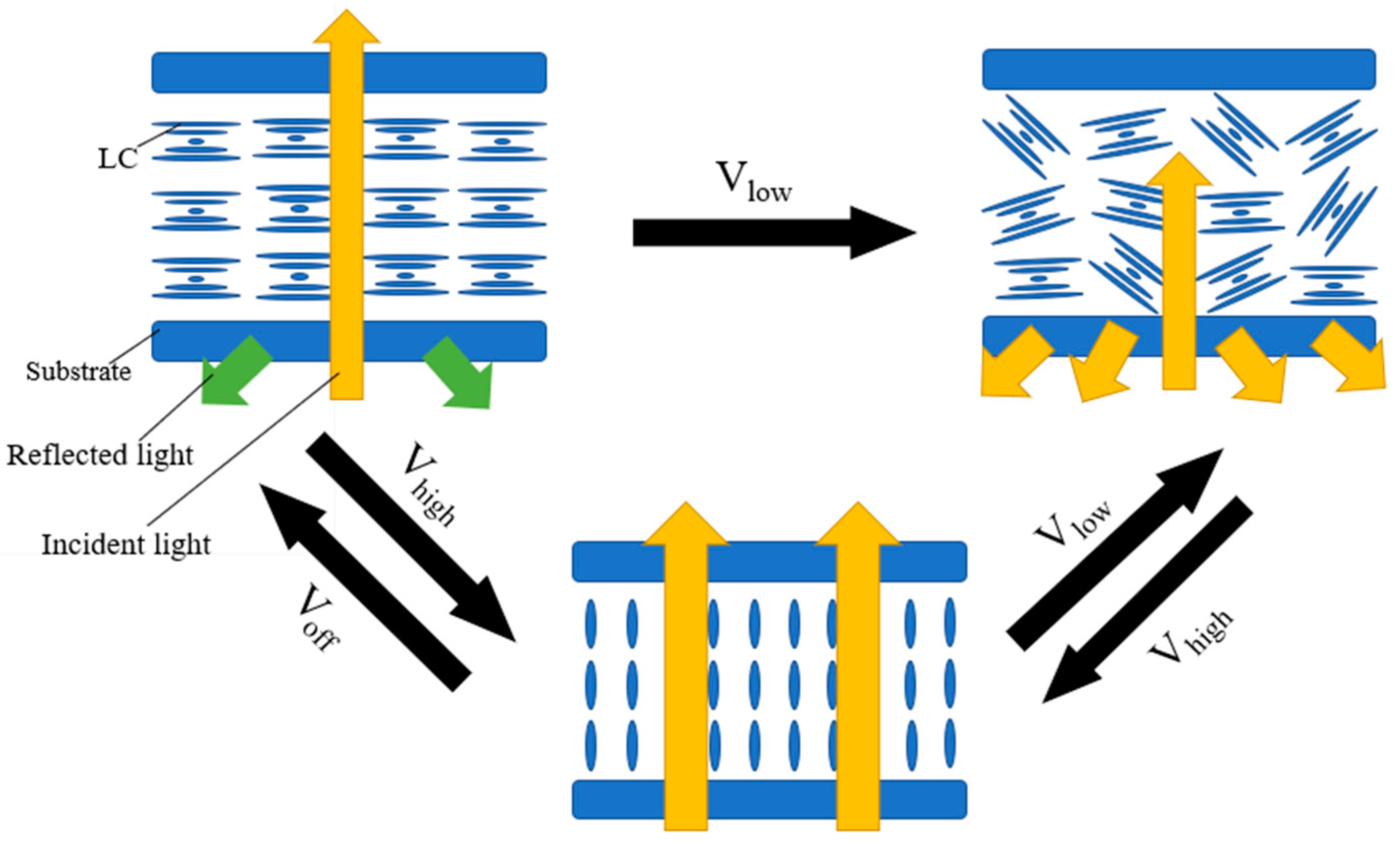
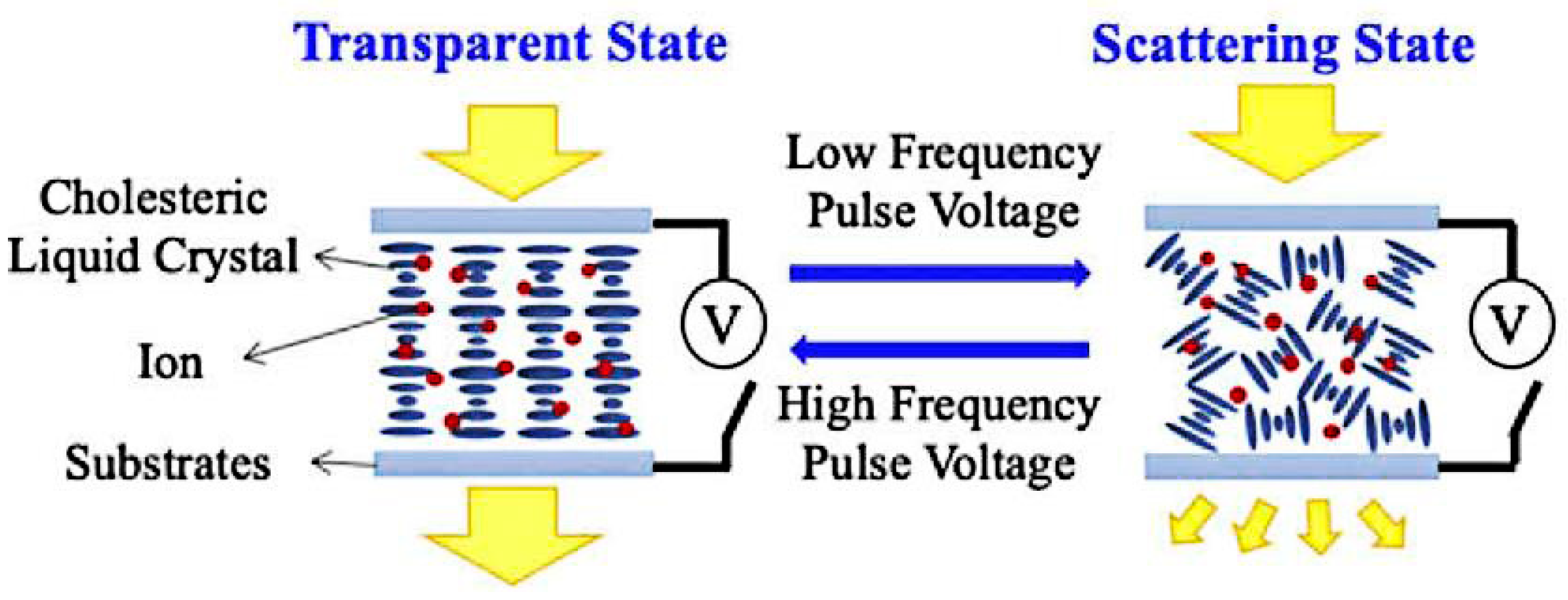
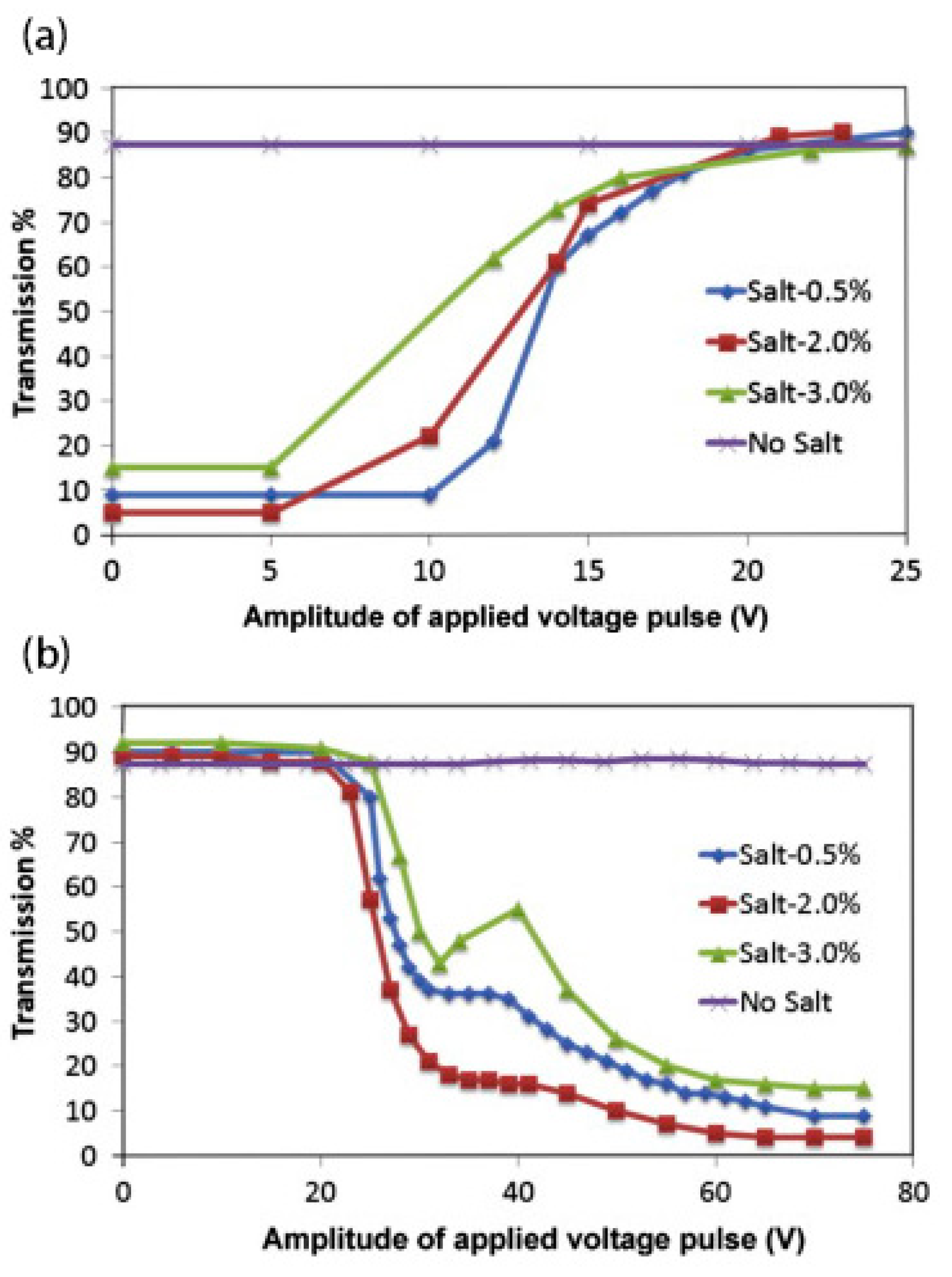
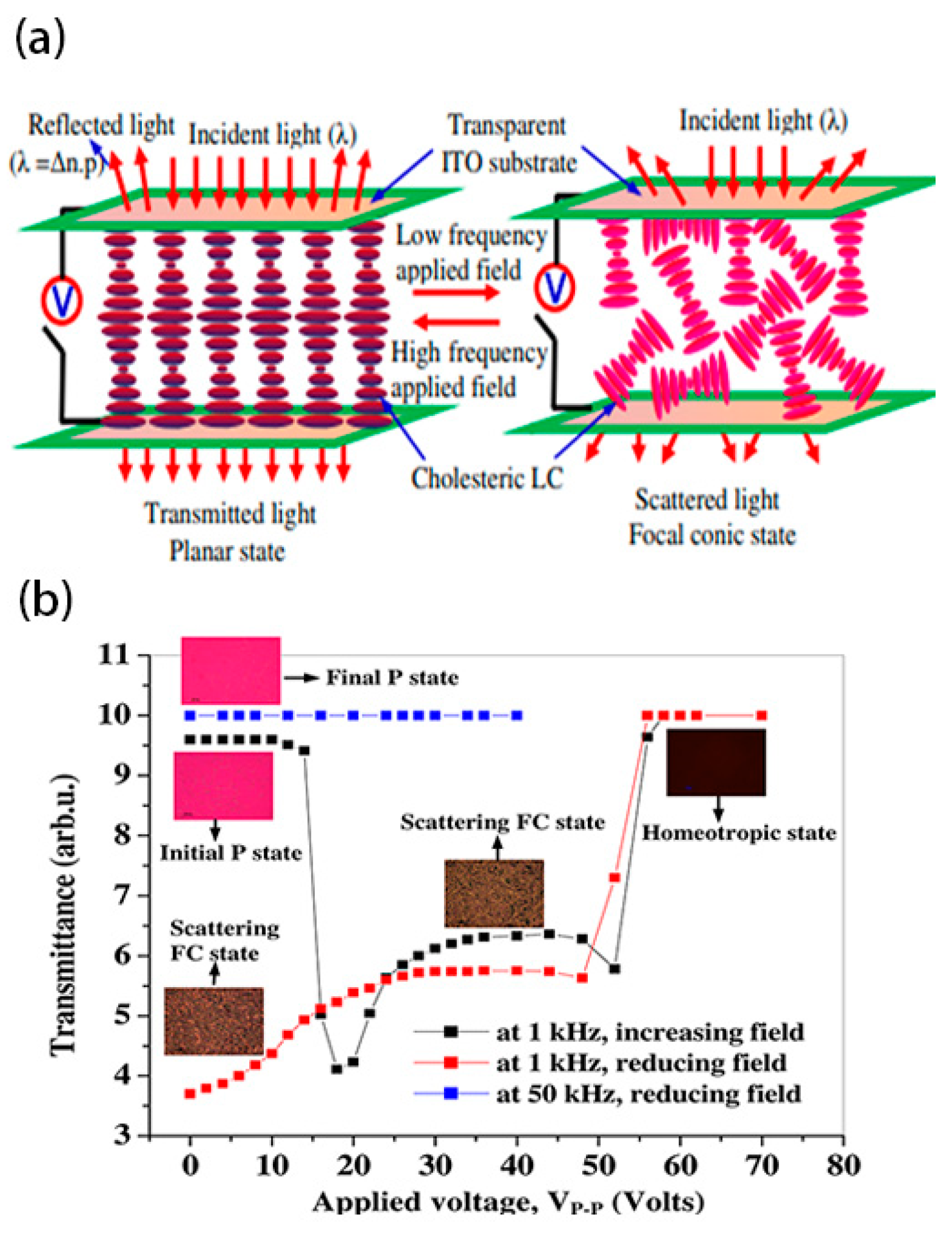

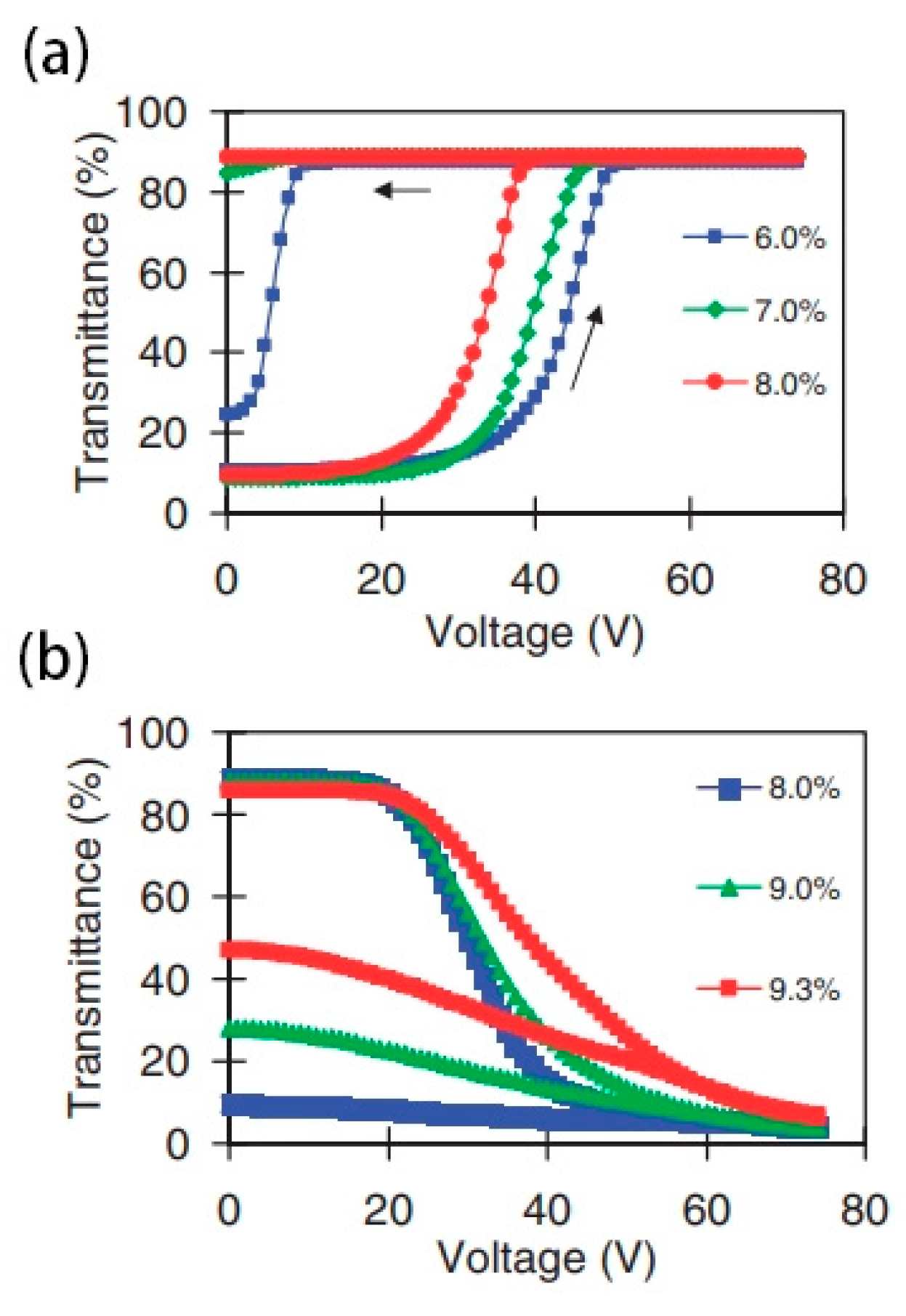
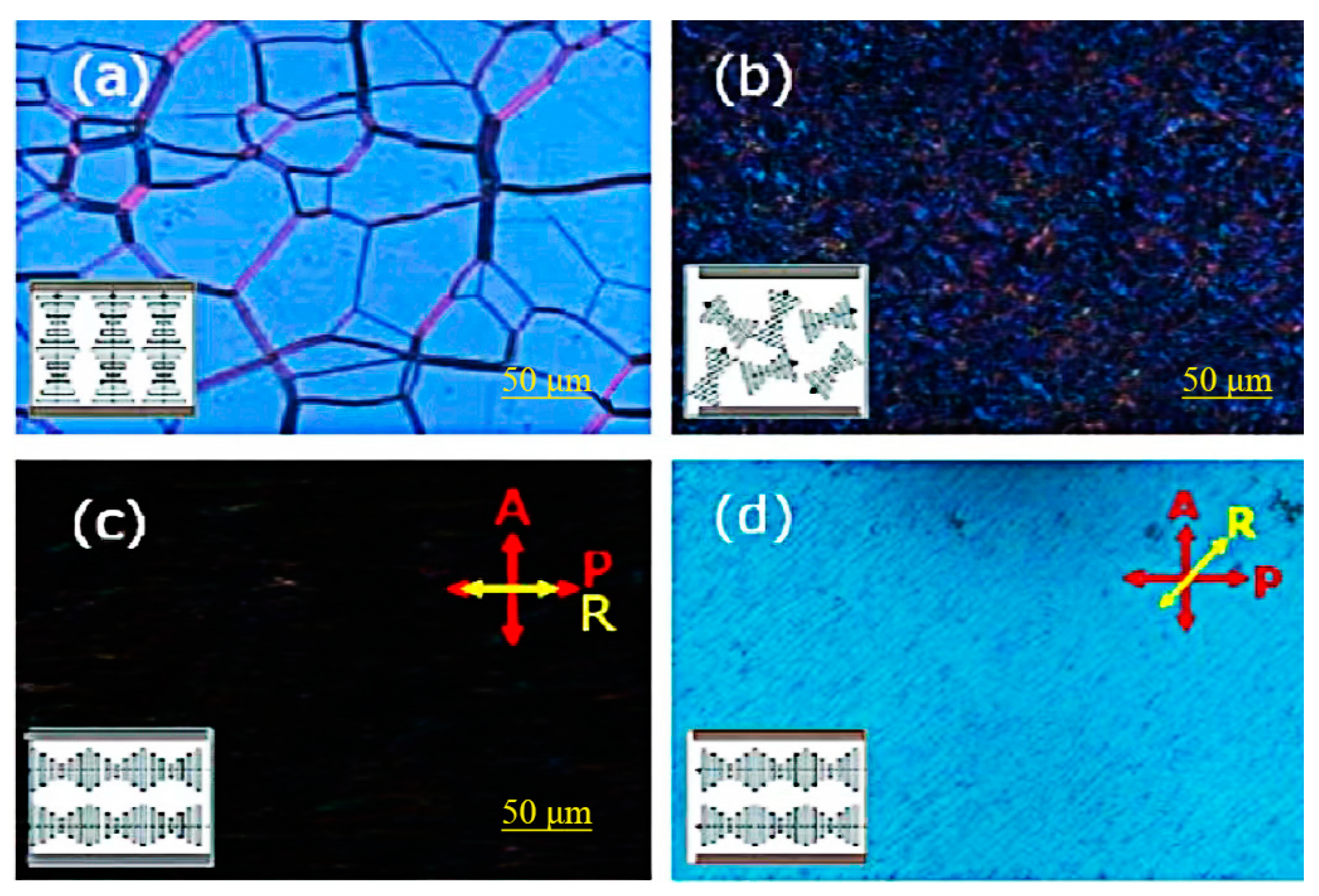
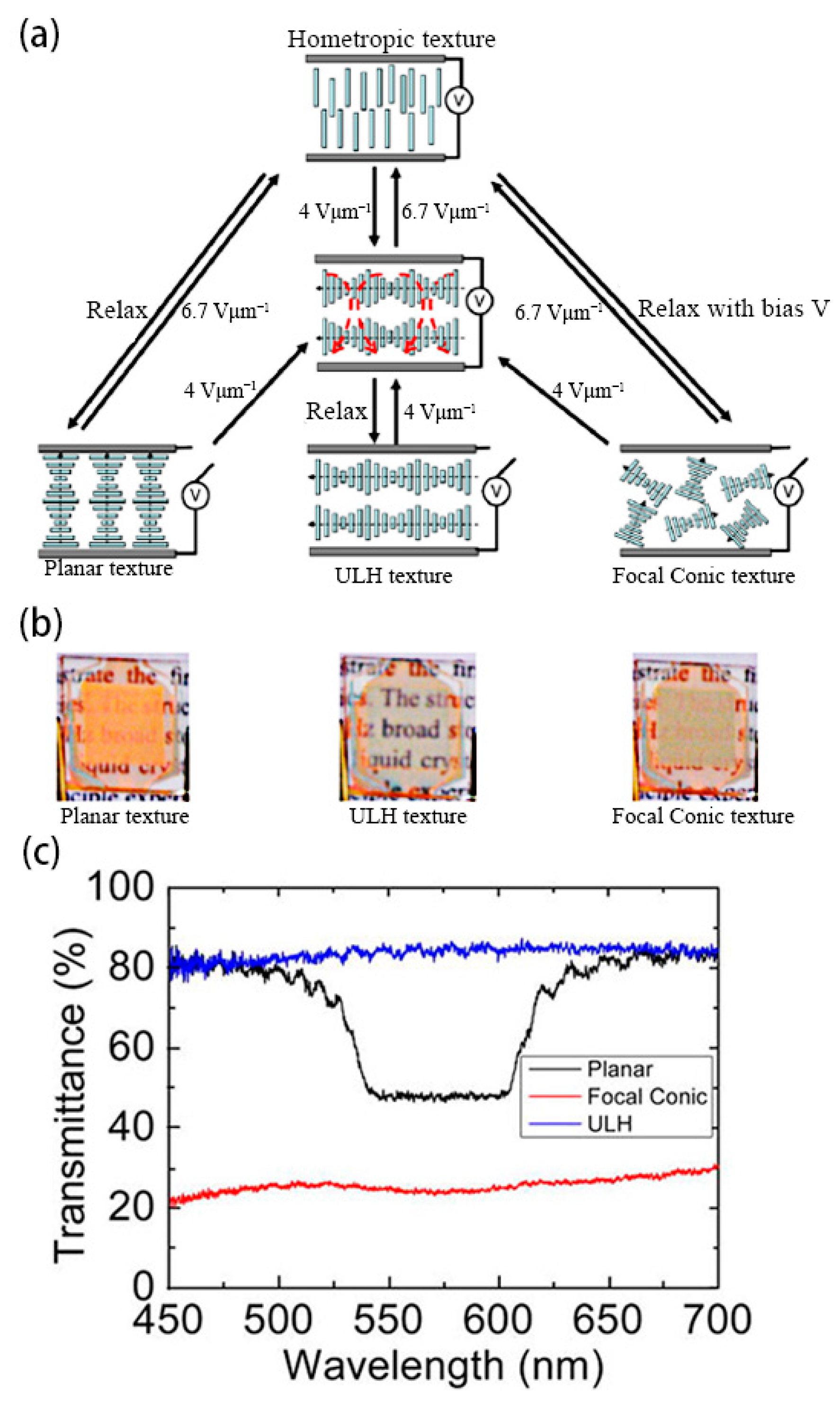

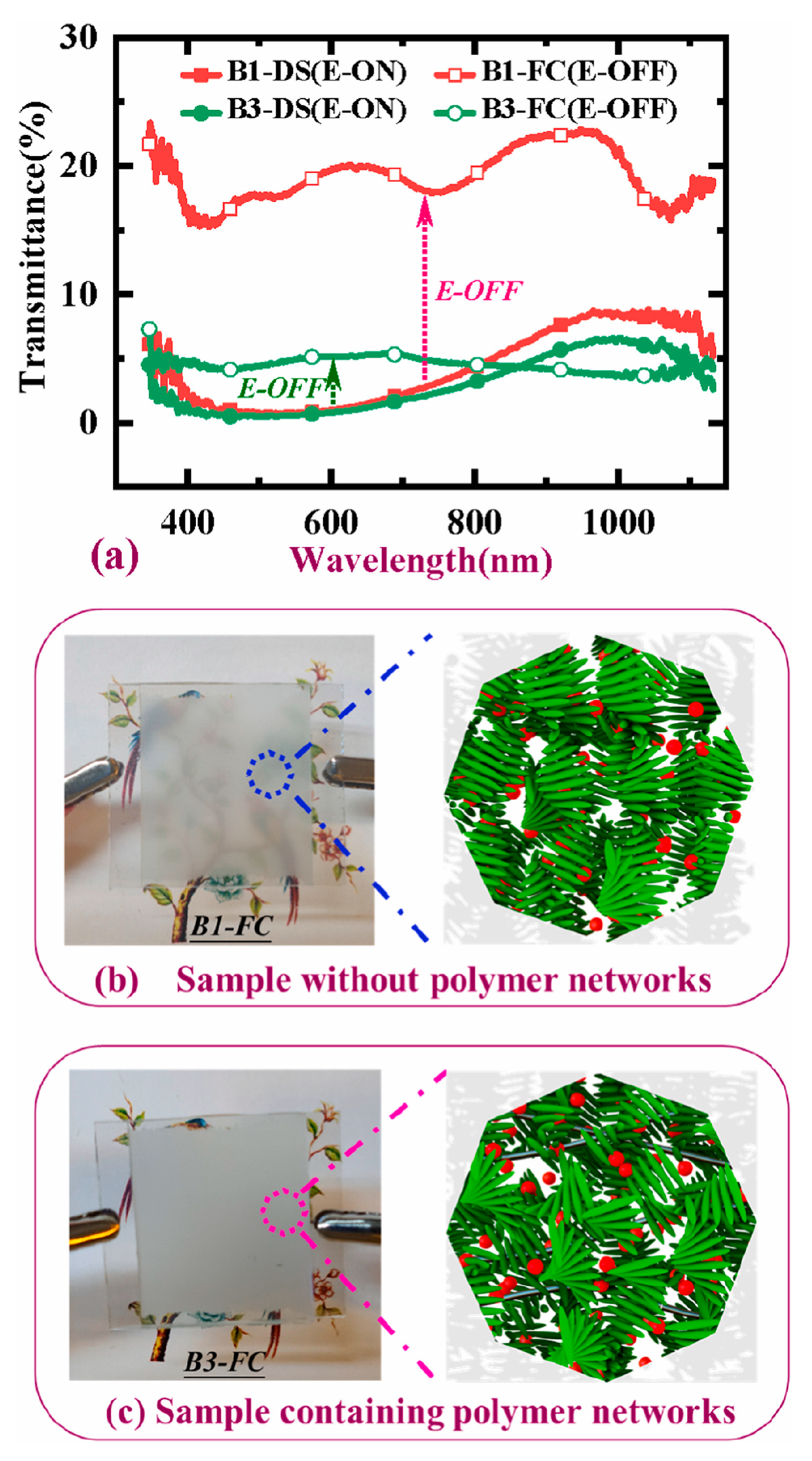

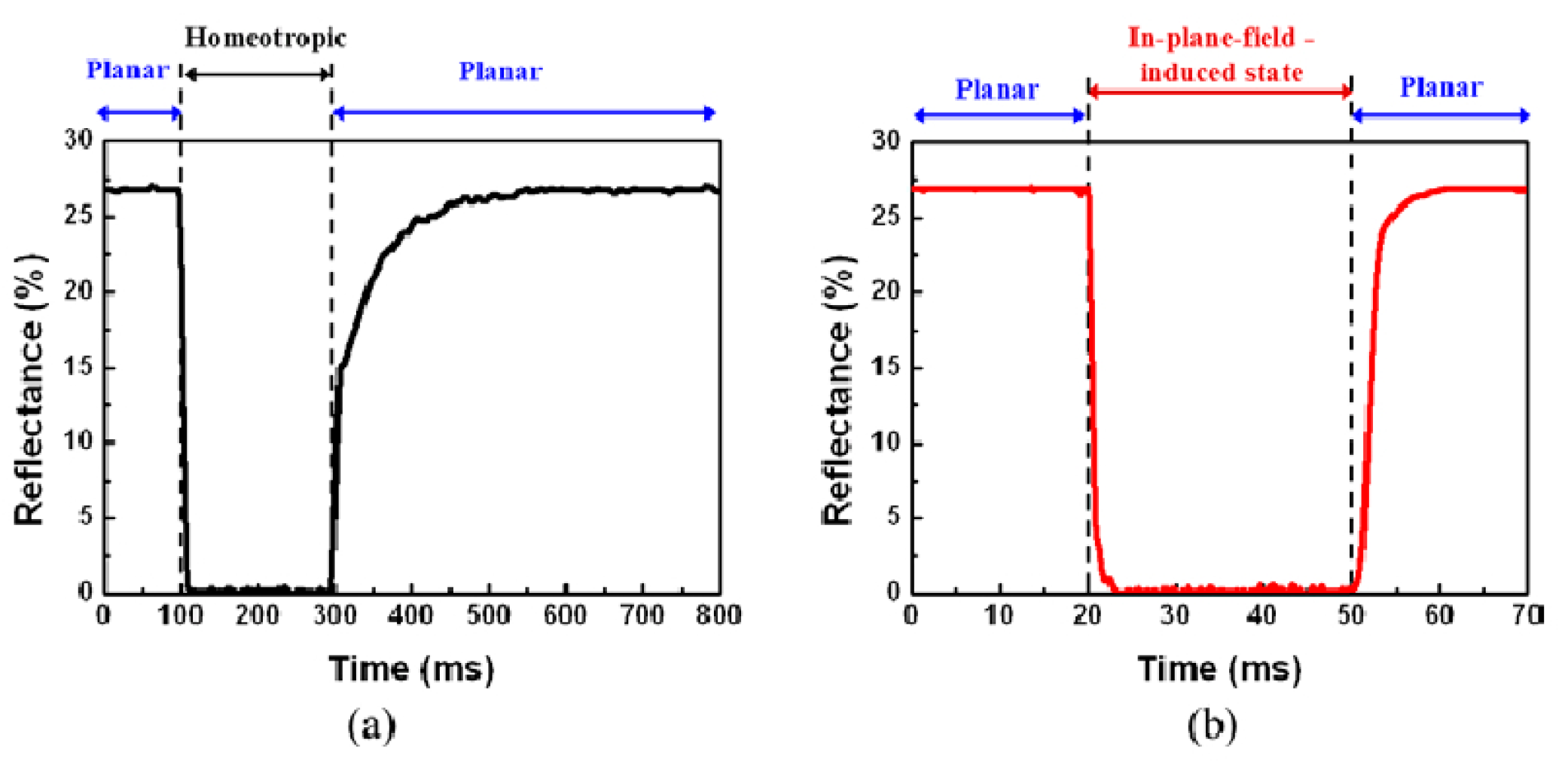

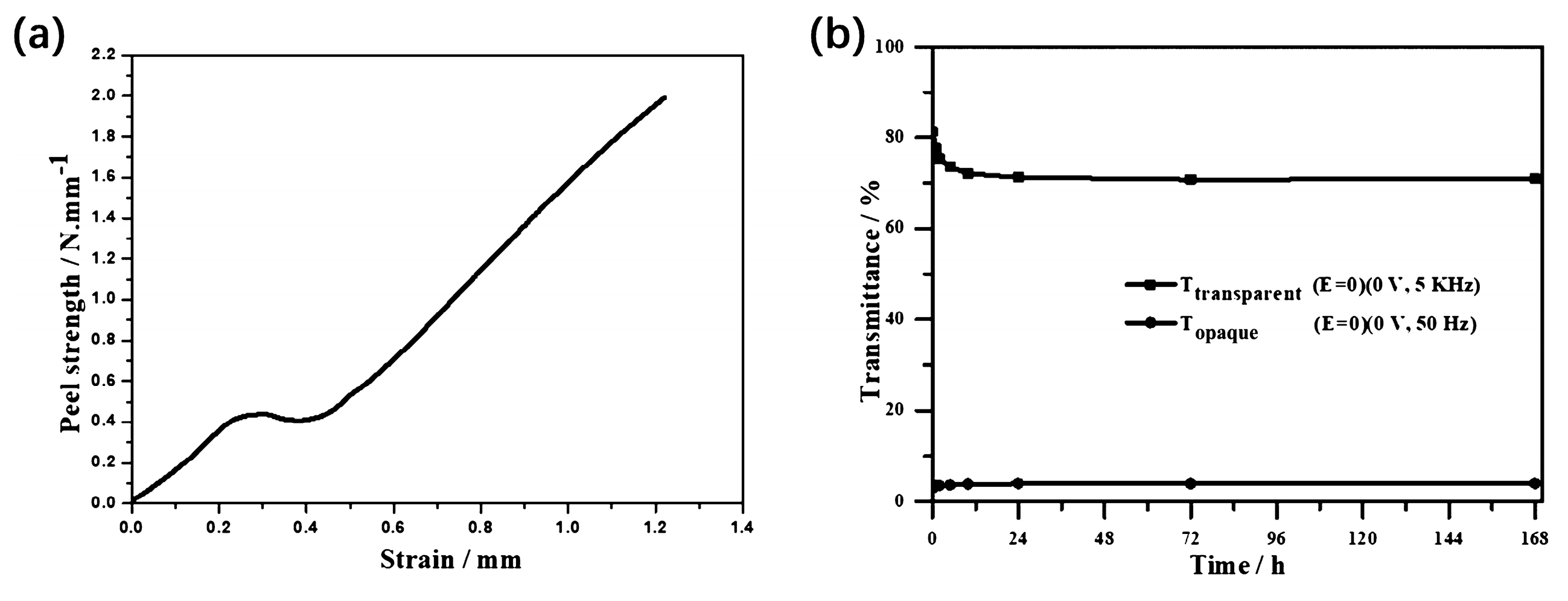


Disclaimer/Publisher’s Note: The statements, opinions and data contained in all publications are solely those of the individual author(s) and contributor(s) and not of MDPI and/or the editor(s). MDPI and/or the editor(s) disclaim responsibility for any injury to people or property resulting from any ideas, methods, instructions or products referred to in the content. |
© 2023 by the authors. Licensee MDPI, Basel, Switzerland. This article is an open access article distributed under the terms and conditions of the Creative Commons Attribution (CC BY) license (https://creativecommons.org/licenses/by/4.0/).
Share and Cite
Wang, K.; Hu, W.; He, W.; Yang, Z.; Cao, H.; Wang, D.; Li, Y. Research Progress of Electrically Driven Multi-Stable Cholesteric Liquid Crystals. Materials 2024, 17, 136. https://doi.org/10.3390/ma17010136
Wang K, Hu W, He W, Yang Z, Cao H, Wang D, Li Y. Research Progress of Electrically Driven Multi-Stable Cholesteric Liquid Crystals. Materials. 2024; 17(1):136. https://doi.org/10.3390/ma17010136
Chicago/Turabian StyleWang, Kainan, Wentuo Hu, Wanli He, Zhou Yang, Hui Cao, Dong Wang, and Yuzhan Li. 2024. "Research Progress of Electrically Driven Multi-Stable Cholesteric Liquid Crystals" Materials 17, no. 1: 136. https://doi.org/10.3390/ma17010136
APA StyleWang, K., Hu, W., He, W., Yang, Z., Cao, H., Wang, D., & Li, Y. (2024). Research Progress of Electrically Driven Multi-Stable Cholesteric Liquid Crystals. Materials, 17(1), 136. https://doi.org/10.3390/ma17010136






